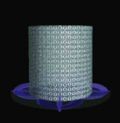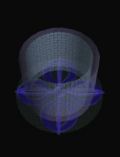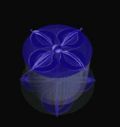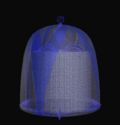Protective tent: Difference between revisions
No edit summary |
m (grammar) |
||
| Line 1: | Line 1: | ||
'''The protective tent''' (Tib. བསྲུང་གུར་, ''sung gur'', [[Wyl.]] ''bsrung gur'') and protective spheres (Tib. བསྲུང་འཁོར་, ''sung khor'', Wyl. ''bsrung 'khor'') sometimes called 'vajra tent,' are meditated upon in [[Vajrayana]] [[sadhana]] practices to prevent any negative influence from entering the practice space. It is usually done after expelling the [[obstacle maker]]s and preserved throughout the whole duration of the practice. The traditional example to illustrate this is | '''The protective tent''' (Tib. བསྲུང་གུར་, ''sung gur'', [[Wyl.]] ''bsrung gur'') and protective spheres (Tib. བསྲུང་འཁོར་, ''sung khor'', Wyl. ''bsrung 'khor'') sometimes called 'vajra tent,' are meditated upon in [[Vajrayana]] [[sadhana]] practices to prevent any negative influence from entering the practice space. It is usually done after expelling the [[obstacle maker]]s and preserved throughout the whole duration of the practice. The traditional example to illustrate this is thoroughly locking oneself in after expelling thieves out of the house. There are the relative and the absolute protective tents. | ||
Visualisation of protective spheres can be more or less elaborate. In its simplest form it is a vajra tent formed of a large [[double vajra]] with all the intervals filled with smaller [[vajra]]s so that it is impenetrable. The following animation shows a more complex one, as described by [[Khenpo Chemchok]] in his [[The Words of the Vidyadhara which Bestow the Majesty of Great Bliss|commentary]] to the [[Rigdzin Düpa]] sadhana. | Visualisation of protective spheres can be more or less elaborate. In its simplest form it is a vajra tent formed of a large [[double vajra]] with all the intervals filled with smaller [[vajra]]s so that it is impenetrable. The following animation shows a more complex one, as described by [[Khenpo Chemchok]] in his [[The Words of the Vidyadhara which Bestow the Majesty of Great Bliss|commentary]] to the [[Rigdzin Düpa]] sadhana. | ||
Latest revision as of 16:55, 2 April 2024
The protective tent (Tib. བསྲུང་གུར་, sung gur, Wyl. bsrung gur) and protective spheres (Tib. བསྲུང་འཁོར་, sung khor, Wyl. bsrung 'khor) sometimes called 'vajra tent,' are meditated upon in Vajrayana sadhana practices to prevent any negative influence from entering the practice space. It is usually done after expelling the obstacle makers and preserved throughout the whole duration of the practice. The traditional example to illustrate this is thoroughly locking oneself in after expelling thieves out of the house. There are the relative and the absolute protective tents.
Visualisation of protective spheres can be more or less elaborate. In its simplest form it is a vajra tent formed of a large double vajra with all the intervals filled with smaller vajras so that it is impenetrable. The following animation shows a more complex one, as described by Khenpo Chemchok in his commentary to the Rigdzin Düpa sadhana.
Animation of the Protection Spheres
The animation is a Flash file, so you'll need a Flash player or Flash extension on your browser.
Khenpo Chemchok's explanation of the different parts is given below.
(click on the yellow arrow in the right corner to play the animation)
<swf width="640" height="480">http://www.rigpawiki.org/Media/Video/ProtectionTent.swf</swf>
The animation can be downloaded by right clicking Protective Tent Animation and choose "save as".
The Relative Protection Spheres
Formation
Your heart emanates wrathful deities, weapons and masses of flame. At the same time, the wrathful weapons and flames you sent out earlier to expel the negative forces now return towards you. At the point where they meet, the vajra sphere is formed, like liquid metal being poured into a cast.
The Ground

The ground transforms into a great crossed vajra. Small, and even smaller vajras fill all the gaps around and inside the main vajras, so that there is not even one tiny gap remaining.
The Inner Layer

Arising around the edge of the circular ground is a solid and unyielding wall of standing vajras. Again, all the gaps in this perimeter fence are filled with smaller vajras.
The Outer Layer: The Net of Vajras

Outside this is a net of vajras interlaced in squares, the spokes parallel to the circumference.
The Vajra Canopy

Above this net lies the vajra canopy, which is formed by a large double vajra. Again, all conceivable gaps are filled with tiny vajras. At the four tips of the double vajra are small half vajras that point slightly upwards.
The Intermediate Layer
In the space between the first and second layers of the protective sphere, there is another net of vajras, hanging down like a curtain from the top of the vajra canopy. It looks like a cup with a sealed top.
The Vajra Tent

The vajra tent has the shape of a dome and covers all the other layers of the sphere. It is formed from a crossed vajra. The four spokes of the vajras slope downwards, all the way to the ground. As before, any space is totally filled with tiny vajras. The tent covers the spokes of all the vajras, including those of the standing vajras, and looks like an iron helmet. At the summit is a blue vajra with outspread spokes. All around the perimeter of the tent blaze the fires of the end of time.
The Surroundings
Imagine that an infinite number of wrathful deities and weapons spread outwards from the protective tent. They scatter and annihilate all negative influences.